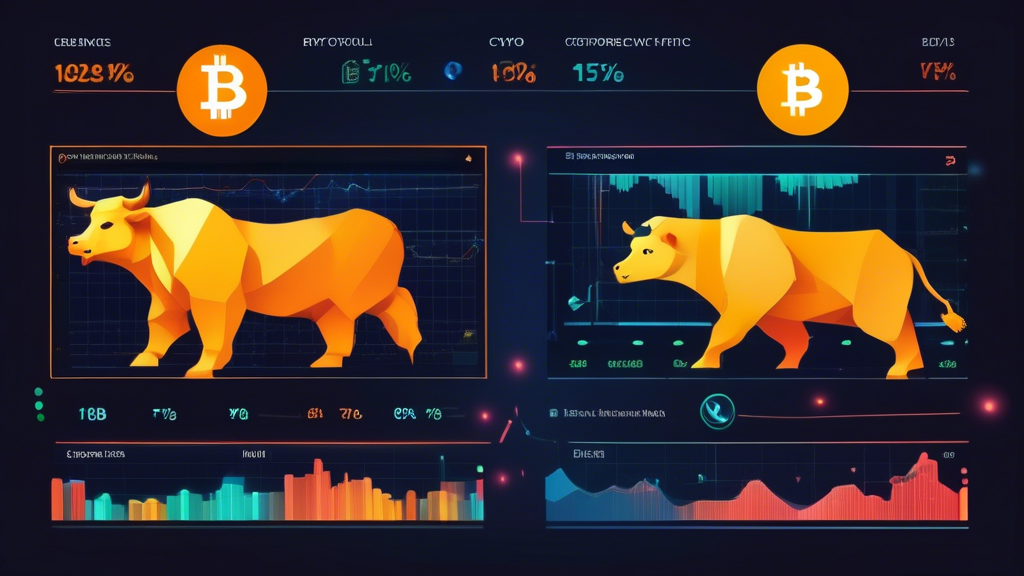In the ever-evolving landscape of financial markets, understanding the methods of trading is crucial for…
Decoding Success: Comparing Crypto Trading and Professional Trading Strategies

In recent years, the financial landscape has experienced a transformative shift with the rise of cryptocurrency, creating new avenues and challenges for traders. Crypto trading has emerged as a dynamic field, characterized by rapid price fluctuations and a continuously evolving market environment. It involves the buying and selling of digital assets such as Bitcoin, Ethereum, and an array of altcoins with the goal of capitalizing on volatility for profit. On the other hand, traditional professional trading encompasses a broad spectrum of financial instruments like stocks, bonds, and commodities, conducted in well-established markets with regulated frameworks. This comparison of crypto trading and professional trading strategies is essential as both have garnered immense popularity, each offering unique opportunities and requiring distinctive skills and approaches. The objective of this article is to delve into these two realms of trading to decode what constitutes success within each sphere, aiming to provide valuable insights for both novice and experienced traders.
The allure of crypto trading lies in its decentralized nature and the potential for significant returns, yet it comes with heightened risk given its nascent market structure and lack of regulatory oversight. This contrasts with professional trading, where regulations are stringent, and markets are more stable but often yield slower growth. Understanding the nuances between these trading strategies is crucial as they dictate how traders approach the market, manage risks, and ultimately achieve success.
For those interested in expanding their knowledge, resources such as [Investopedia’s Guide to Cryptocurrency Trading](https://www.investopedia.com/cryptocurrency-4427699) and the [SEC’s Basics of Stock Market Trading](https://www.sec.gov/oiea/investor-alerts-and-bulletins/ib_tradingbasics.html) offer comprehensive overviews of both crypto and professional trading domains. Our exploration will illuminate the key differences in market dynamics and the common thread of strategic thought that binds these two worlds, allowing traders to refine their tactics and achieve their trading goals effectively.
Introduction to Crypto Trading and Professional Trading
Crypto trading and professional trading represent two evolving dimensions of the financial markets, each with its unique appeal and strategy. At their core, both involve buying and selling assets with the aim of generating profit, yet they diverge in their methods, environments, and often the types of assets traded. This section will provide a snapshot of what each entails and why they have gained immense popularity.
- Crypto Trading: Crypto trading involves the buying and selling of digital currencies, such as Bitcoin, Ethereum, and others. Traders engage on platforms like Binance, Coinbase, and Kraken, where cryptocurrencies are exchanged. The market operates 24/7, making it highly dynamic and accessible. The rapid price fluctuations present both opportunities and risks, attracting individuals who are keen on short-term gains.
- Professional Trading: Traditional or professional trading often takes place in well-established markets like stocks, commodities, bonds, and forex. This type of trading is typically conducted by individuals or institutions through exchanges such as the New York Stock Exchange (NYSE) or the Foreign Exchange Market (Forex). Professional trading is characterized by more stable regulations and trading hours, usually adhering to the financial centers’ business times.
The growing importance of both trading strategies cannot be overstated. According to Statista, the number of cryptocurrencies has surged to over 10,000 as of 2023, highlighting the ecosystem’s expansion. Meanwhile, traditional trading has continued to evolve with technological advancements, integrating sophisticated analytical tools and platforms.
The objective of this article is to draw a comparative analysis between crypto trading and professional trading strategies, aiming to decode what contributes to success in these fields. Understanding this can empower traders to optimize their strategies across both spectrums.
Growing Popularity of Trading Strategies
- Accessibility: Both markets have become increasingly accessible with the advent of online trading platforms and applications. For crypto trading, platforms such as Binance or Coinbase provide user-friendly interfaces, while platforms like eToro and Interactive Brokers cater to professional trading.
- Technological Integration: Automation and algorithmic trading have become pivotal in both domains. The use of artificial intelligence and machine learning algorithms in crypto and professional trading facilitates rapid analysis and execution of trades, potentially enhancing profitability.
- Educational Resources: The proliferation of educational content and trading communities online supports traders in both fields. Whether it’s through webinars, forums like Reddit Cryptocurrency, or professional courses, aspiring traders have more resources than ever to hone their skills.
Both crypto and professional trading have cemented themselves as viable avenues for individuals seeking alternative income streams or those wishing to venture into the world of financial markets. By comparing their strategies, traders can glean insights that may help refine their approaches to achieving success.
For further reading, you may consider looking into resources such as Investopedia’s best online brokers or Cryptocurrency Facts, which offer weekly updates and analysis tailored to budding and seasoned traders alike.

Key Differences Between Crypto Trading and Professional Trading Strategies
Market Dynamics and Volatility
The market dynamics in crypto trading significantly differ from those in traditional professional trading. A primary factor is volatility. Cryptocurrencies are known for their sharp price swings within short periods. For instance, Bitcoin, the leading cryptocurrency, has experienced major fluctuations, with its price sometimes changing by double digits in a single day. In contrast, traditional financial markets, such as stocks or forex, generally exhibit lower volatility, with price changes occurring more predictably over time.
- Crypto Trading:
- High volatility leading to potential for greater rewards but also higher risks.
- Markets open 24/7, providing continuous trading opportunities.
- Professional Trading (Traditional Markets):
- Relatively lower volatility, allowing for more gradual strategies.
- Defined trading hours, typically aligned with regional stock exchanges.
Traders in both sectors must tailor their strategies to account for these differences. Those in crypto might employ techniques such as scalping or day trading to capitalize on short-term opportunities, while traditional traders often engage in position trading or swing trading based on longer-term market trends.
Regulatory Frameworks
Another critical distinction between crypto trading and professional trading lies in the regulatory environments. Traditional financial markets have longstanding regulatory frameworks designed to protect investors and maintain market integrity.
| Trading Type | Regulatory Characteristics |
|---|---|
| Crypto Trading | Often lacks comprehensive regulation, varying significantly across jurisdictions. This can create a dynamic but uncertain trading environment. Traders should stay informed about rapidly changing policies. |
| Professional Trading | Subject to strict regulatory oversight (e.g., SEC in the USA, FCA in the UK), providing structured guidelines and protections but potentially limiting certain high-risk strategies. |
These disparities mean that crypto traders must remain vigilant of regulatory shifts that can impact market access or alter trading incentives, whereas professional traders operate within a more consistent framework.
Risk Management Techniques
Risk management is at the core of both crypto and professional trading strategies, yet the approaches often vary due to the inherent differences in market volatility and regulation.
- Crypto Trading Risk Management:
- Stop-Loss Orders: Frequently used due to high volatility to limit potential losses.
- Portfolio Diversification: Spreading investments across multiple cryptocurrencies to mitigate risk exposure.
- Stablecoins: Utilizing stablecoins to park funds when markets are unstable.
- Professional Trading Risk Management:
- Hedging: Utilizing financial derivatives like options and futures to hedge against market downturns.
- Asset Allocation: Diversifying across asset classes such as stocks, bonds, and commodities.
- Risk Adjusted Returns: Focus on achieving optimal returns relative to the risk taken.
Understanding these risk management strategies allows traders to better navigate the complexities of their respective markets and can be crucial in securing long-term success.
For further reading on the impact of regulatory frameworks on trading strategies, you may find the following resources helpful:
- Understanding SEC Regulation (Investopedia)
- Cryptocurrency Regulation News (CNBC)

Similarities in Crypto Trading and Professional Trading Approaches
While crypto trading and professional trading in traditional markets possess distinct characteristics due to their market environments, a number of strategies and principles unite them. Understanding these commonalities can provide traders with valuable insights and enhance their trading proficiency.
Common Strategies: Technical Analysis and Market Sentiment Analysis
- Technical Analysis: Both crypto traders and professional traders rely heavily on technical analysis to predict future price movements. This involves studying patterns in historical price data and using indicators such as moving averages, candlestick patterns, and relative strength indices (RSI). The fundamental premise is to identify trends and possible entry or exit points, irrespective of the asset being traded.
- Market Sentiment Analysis: Understanding the mood of the market participants is crucial in both arenas. Traders utilize sentiment analysis tools to gauge market emotions, which can significantly influence price movements. This might involve analyzing news, social media trends, or specific indicators that reflect market optimism or pessimism.
Both strategies enable traders to make informed decisions in highly dynamic environments, bridging the gap between the seemingly disparate worlds of crypto and traditional trading.
The Role of Discipline, Emotional Control, and Continuous Learning
- Discipline: Maintaining a disciplined approach is essential in both markets. This includes adhering to trading plans, setting stop-losses, and managing risk judiciously. Discipline helps prevent impulsive decisions that can lead to significant losses.
- Emotional Control: Emotional responses such as fear and greed can cloud judgment. Both crypto and professional traders develop strong mental fortitude to remain calm under pressure. Techniques such as mindfulness and psychological training are invaluable in honing this skill.
- Continuous Learning: The trading landscape is continually evolving, making it vital for traders to keep updating their knowledge. This involves staying abreast of market news, understanding new technologies (especially in crypto with blockchain advancements), and learning from past trades. Engaging with courses, webinars, and forums plays a crucial role in staying competitive.
For more insights into developing these skills, traders can refer to resources like Investopedia’s Guide to Making a Trading Plan.
Capitalizing on Market Trends and Price Movements
- Identifying Market Trends: Whether in crypto or traditional markets, trend identification is a key strategy for profitability. Traders hone skills in recognizing bullish or bearish trends and positioning themselves accordingly. Tools like trend lines and Fibonacci retracements are commonly used.
- Exploiting Price Movements: Both types of traders aim to profit from price changes. This involves deciding whether to take a long or short position based on market analysis. Despite the differing levels of volatility, the core objective remains to capitalize on discrepancies in pricing to earn substantial returns.
In essence, while crypto trading and professional trading might diverge in certain operational aspects, the strategic mindset involving analysis, discipline, and adaptability unites them. Traders seeking success should strive to master these common areas, enabling them to navigate both environments efficiently.
For a deeper understanding of these trading strategies, including dedicated tutorials and expert discussions, traders can explore platforms such as BabyPips and TradingView, which offer valuable resources and community support.

Evaluating Success: Metrics and Strategies in Crypto vs. Professional Trading
Understanding the metrics and strategies that define success in crypto trading and professional trading is crucial for traders in both fields. By analyzing these elements, traders can optimize their approaches and potentially improve their outcomes. Here we explore key metrics and strategies employed in crypto trading and professional trading to evaluate their success.
Metrics for Measuring Success
Both crypto and professional trading use a variety of metrics to assess success:
- Return on Investment (ROI): This metric measures the ratio of profit or loss generated relative to the invested capital. It is applicable to both markets, providing a straightforward assessment of trading performance.
- Sharpe Ratio: The Sharpe Ratio evaluates the risk-adjusted returns of a trading strategy. A higher Sharpe Ratio indicates a better risk-adjusted performance, making it a critical metric for traders seeking to balance risk and reward.
- Win Rate: This represents the percentage of profitable trades made over a specific period. While traders aim for a high win rate, the profitability of trades should also be considered, as some strategies have a lower win rate but higher profits per trade.
- Drawdown: Measuring the peak-to-trough decline during a specific period, drawdown helps traders understand potential losses and adjust their strategies to minimize risk.
While these metrics provide valuable insights, traders often supplement them with more industry-specific measures. For instance, in crypto trading, metrics like market sentiment and blockchain analysis play a crucial role, whereas professional trading might rely more heavily on macroeconomic indicators and interest rates.
Strategies that Determine Success
Success in both crypto trading and professional trading can also be attributed to certain well-defined strategies:
Algorithmic Trading
Algorithmic trading, or the use of computer algorithms to execute trades based on predefined criteria, is prevalent in both sectors. In crypto trading, algorithmic systems can rapidly adapt to the highly volatile nature of the market, while in professional trading, these algorithms are used to exploit inefficiencies in traditional markets and execute high-frequency trades.
For more insights into algorithmic trading strategies, explore this Investopedia article on algorithmic trading strategies.
Fundamental Analysis
Fundamental analysis differs between the two trading types; in professional trading, it involves evaluating financial statements and global economic factors. In contrast, crypto trading fundamental analysis may focus on the project’s white paper, tokenomics, and underlying technology.
For additional resources, Binance delves into how to perform fundamental analysis on cryptocurrencies.
Technical Analysis
Both crypto and professional traders extensively utilize technical analysis to forecast future price movements based on past market data. Key aspects include:
| Chart Patterns | Usage |
|---|---|
| Candlestick Patterns | Identify potential market reversals and continuations. |
| Trend Lines | Determine the general direction or trend of the market. |
| Support and Resistance Levels | Guide traders on key price levels to watch for potential breaks or bounces. |
Technical analysis remains a cornerstone for traders in both fields due to its adaptability and ability to provide data-driven insights regardless of the asset class.
Combining Insights from Both Trading Types
Traders can enhance their strategies by cross-applying successful tactics from each realm:
- Adapting to Market Volatility: Crypto traders can learn from professional traders’ risk management techniques to mitigate severe downturns, while professional traders might take cues from crypto’s rapid adaptability to changing market conditions.
- Diversification Strategies: Incorporating diversified assets, as seen in professional trading, can help crypto traders spread risk efficiently within their portfolios.
- Regulatory Awareness: Both groups can benefit from increased awareness of regulatory changes, which is often more volatile in the crypto sphere but subtly impacts traditional trading as well.
The successful evaluation of strategies and metrics in crypto trading and professional trading not only guides individual decisions but also opens avenues for cross-learning. By leveraging strengths from both domains, traders can create more robust and dynamic trading strategies, enhancing their potential for achieving their financial goals.
In conclusion, the intricate world of trading offers a diverse spectrum of strategies and approaches, each uniquely tailored to its market environment—crypto trading and professional trading being two prominent areas of focus. The article has delved deep into both more abstract elements and nuanced details of these trading realms, offering comparative insights that decode what success entails in each.
The fundamental differences between crypto trading and professional trading lay the groundwork for understanding their distinct ethos. The high volatility and fluid market dynamics of cryptocurrencies pose both challenges and opportunities, contrasting with the generally more stable and historically matured conventional financial markets. Regulatory frameworks further compound these differences, impacting how strategies are crafted and executed in both areas. Crypto trading often operates in a less regulated space, offering agility and expansiveness, while professional trading adheres to stricter regulatory guidelines, focusing more on risk mitigation and compliance.
Similarly, both trading strategies encapsulate key similarities that define successful trading. Technical analysis and market sentiment analysis are integral tools used across both sectors. The article highlights the critical role of trader psychology, emphasizing discipline, emotional regulation, and the importance of ongoing education in an ever-evolving trading landscape. These attributes create a bridge between the two trading worlds, emphasizing that despite their differences, success requires a unified set of skills and mindsets.
In evaluating success, a multifaceted approach is crucial in both crypto and professional trading. Success metrics may vary, ranging from return on investment and risk-adjusted returns to more nuanced algorithmic outcomes and the efficacy of fundamental analysis. Importantly, the article underscores the potential for cross-pollination of ideas, where insights and strategies can be shared among crypto and professional trading, fostering innovation and enhancing overall trading acumen.
Traders striving for success in either or both markets can benefit from embracing the attributes and strategies that have proven effective across the board. By understanding and applying a balanced mix of technical skills, analytical methodologies, and psychological preparedness, they position themselves to navigate the complexities of the trading world more effectively. Overall, this comparative exploration into crypto trading and professional trading not only decodes the essence of success but also enriches the trader’s toolkit, driving forward their endeavor to harness market opportunities.
For further insights into trading strategies and larger market contexts, readers may explore resources from established bodies such as the [U.S. Securities and Exchange Commission (SEC)](https://www.sec.gov/) and platforms like [CoinDesk](https://www.coindesk.com/) for crypto-specific updates. These resources provide ongoing education and regulatory updates critical for both novice and seasoned traders alike.





